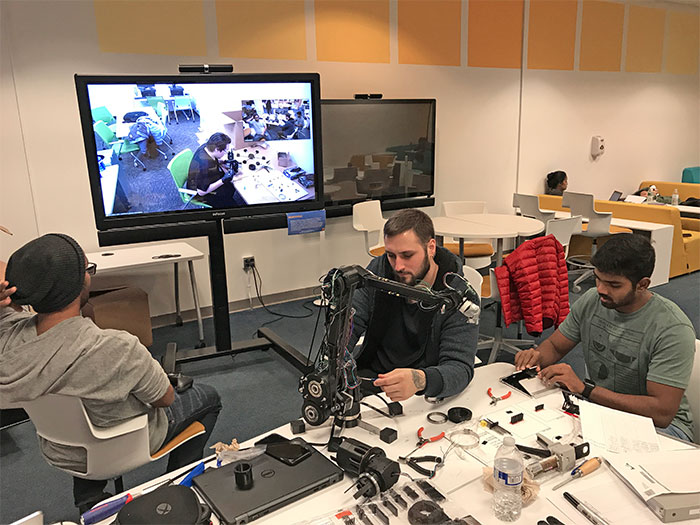
Kicking Bot at NYIT’s Innovation Labs
December 11, 2017
Mechanical engineering student Malu Ribeiro works on a Dexter robot at NYIT’s Innovation Lab in Wisser Library.
Freshman Malu Ribeiro just had her first encounter with a robot.
Inside NYIT-Long Island's Innovation Lab (“iLab”), which is located near the entrance of the Wisser Library, the mechanical engineering student is applying a protective casing to a “Dexter” reconfigurable robot, a mechanical creation she can build using 3-D-printed parts.
Her work exemplifies the “maker-doer culture” that NYIT’s iLabs are designed to foster. In addition to the Wisser location in Long Island, another iLab is located on the third floor of the library at 1855 Broadway in Manhattan. Launched in the fall 2017 semester, these high-tech spaces offer opportunities for NYIT students to learn more about robotics, virtual reality, 3-D printing, multimedia, electronics, and visualization technologies that impact multiple disciplines.
Each location also offers hardware that students can borrow for up to two weeks, including virtual reality headsets, Raspberry Pi and Arduino kits, GoPro cameras, iRobot programmable robots, and other electronic accessories.
Twice weekly robot build workshops, which launched in October, were among the first programs to make use of the space.
“We’re teaching students how to build a robot within a month,” says graduate mechanical engineering student Adhithya Krishnaks, who is mentoring participants in the robot workshops along with students Vignesh Harish and Michael Morgan. “[The students build the robot] from scratch using 3-D-printed components,” Krishnaks explains. The advantage of using these materials, he adds, is that students don't have to worry about breaking robot parts. “If something goes wrong, you can just print them again, quickly and inexpensively,” says Krishnaks.

In Long Island, student workers (from left) Vignesh Harish, Michael Morgan, and Adhithya Krishnaks assist student Michael Bonilla with building his own robot at the NYIT-Manhattan Innovation Lab.
Designed by robot research and development company Haddington Dynamics, Dexter is an ideal starting point for those wishing to understand how robots function and how they can be adapted for a variety of uses. The Dexter model being used in the workshops can lift up to 1 kilogram and features a “modular end effector.” Engineers can attach various tools to the “effector,” which Dexter can then be programmed to use. Ribeiro, for example, attached a pencil to her Dexter that allows the robot to write names on paper. To maneuver Dexter, students use a modified XBox One controller plugged into a laptop.
Ribeiro jumped at the opportunity to play with the technology. “I’ve always wanted to get my hands on these types of things,” she says of the robot.
Growing up in Salvador, Bahia (a Brazilian state about 750 miles north of Rio de Janeiro), Ribeiro transcended gender stereotypes. “As a kid, I loved to tinker and build things,” she says. “But where I grew up, boys got robots to play with and girls were given dolls.” Instead of just playing with her toys, she broke them apart to figure out how they worked.
At NYIT, Ribeiro plans to be a regular at the iLab in Wisser and is working towards completing a certification in robot assembly offered by NYIT.
Student mentors Krishnaks, Harish, and Morgan—who were trained by Haddington Dynamics in Dexter construction and assembly—can also help participants in Manhattan virtually. As Ribeiro builds her robot in Old Westbury, a Mondopad interactive LED display behind her shows a live feed of electrical and computer engineering major Michael Bonilla assembling his own Dexter robot at the NYIT-Manhattan iLab. Krishnaks and the other mentors can help Bonilla by watching his work on the screen and providing feedback.
“The modular design of Dexter allows for different applications,” says Morgan, who is pursuing a bachelor’s degree in mechanical engineering and is interested in the potential for robots to transform design, healthcare, medicine, architecture, and other disciplines. “Instead of sending [doctors] around the world at great cost to perform emergency operations, for example, doctors can be trained to use a robotic arm to perform the procedure from a remote location,” says Morgan.
Harish, a graduate student studying information, network, and computer security, is using his experiences in the iLabs to better understand the mechanical side of programming. “By seeing how everything fits together, you really learn robots inside and out,” he says.
Morgan, Harish, and Krishnaks think all NYIT students at both New York campuses should visit the iLabs.
“We want all different NYIT departments to come together here and interact with robots to see what purposes they can serve,” says Morgan.
The iLabs, located on the first floor of the Wisser Memorial Library (NYIT-Long Island) and the third floor of the NYIT-Manhattan Library, are open during regular library hours. Look out for more stories on The Box highlighting various technologies available at the iLabs.
More Features

An Alumnus’ Commitment to the Environment
As an energy management graduate from New York Tech’s Vancouver campus, Jasdeep Gulati (M.S. ’22) is highly invested in educating people about environmental and climate sustainability.

Vancouver Faculty Win University-Sponsored Research Awards in New Program
The new Global Impact Research Grant (GIRG) program has been developed to keep Vancouver-based faculty connected to faculty and research projects being conducted on the university’s New York campuses.

Studying Climate Change One Degree at a Time
Junhua Qu (M.S. ’24) began her collegiate journey in Beijing. But, her interest in climate change took her to New York Tech’s Vancouver campus to study energy management.
